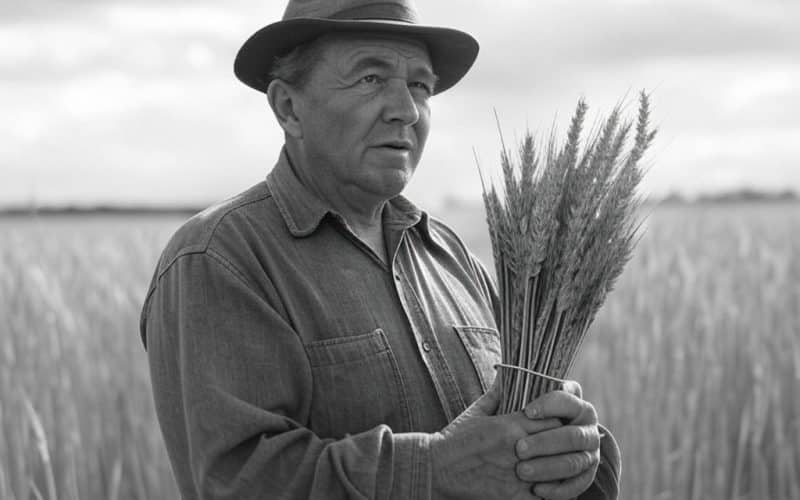
Anno 2025, the name Norman Borlaug does not ring a bell with most people. However, 60 years ago he was hailed as “The Father of the Green Revolution”, because he played a pivotal role in combating global hunger through his groundbreaking work in agricultural science.
All started in 1944, when he joined the Rockefeller Foundation’s initiative in Mexico, focusing on developing high-yield, disease-resistant wheat varieties. His efforts led to the creation of semi-dwarf wheat strains that boosted crop productivity enormously.
In this article we’ll explain his groundbreaking work, the techniques he used but also the side-effects that his work had, plus the solutions to counter these.
Do also check the below video as an introduction to our article.
Who Was Norman Borlaug?
Norman Borlaug was an American agricultural scientist, humanitarian, and Nobel Peace Prize laureate who is widely credited with saving millions of lives from starvation. Born on March 25, 1914, in Iowa, he dedicated his life to improving global food security through advancements in crop breeding and agricultural techniques.
Borlaug led efforts to develop high-yield, disease-resistant wheat varieties. His work in Mexico during the 1940s and 1950s transformed the country from a wheat importer to an exporter, marking the start of his global impact.
Borlaug’s methods were later adopted in countries like India and Pakistan during the 1960s, at a time when they faced severe food shortages. His innovative approach not only boosted agricultural productivity but also helped these nations achieve self-sufficiency in staple crops.
In 1970, he received the Nobel Peace Prize for his contributions to world peace through combating hunger. Throughout his career, Borlaug remained a strong advocate for science-based agricultural innovations, including the use of genetically modified organisms (GMOs), to address the challenges of feeding a growing global population.
The Green Revolution: Transforming Agriculture
By the 1960s, countries like India and Pakistan faced severe food shortages. Borlaug introduced his high-yield wheat varieties and modern agricultural techniques to these regions, resulting in remarkable increases in wheat production. For instance, Pakistan’s wheat yields nearly doubled from 4.6 million tons in 1965 to 7.3 million tons in 1970, achieving self-sufficiency by 1968. Similarly, India saw wheat production rise from 12.3 million tons in 1965 to 20.1 million tons in 1970, reaching self-sufficiency in all cereals by 1974.
I’m a scientist.
— Simon Maechling (@simonmaechling) January 21, 2025
But even among scientists, few can claim what Norman Borlaug did:
He’s credited with saving a billion people from starvation.
How? By changing the way we grow food forever.
Here’s the story of the man
behind the Green Revolution 🧵: 1/ pic.twitter.com/NDbYy43CFr
Later in his career, Borlaug extended his efforts to Africa. In 1984, during the Ethiopian famine, he collaborated with Ryoichi Sasakawa to establish the Sasakawa Africa Association (SAA). This organization aimed to increase food production by introducing improved agricultural practices. Their initiatives led to significant yield improvements in crops like maize, wheat, sorghum, cassava, and cowpeas across several African nations.
Throughout his life, Borlaug remained a staunch advocate for scientific innovation in agriculture. He believed that advancements such as genetically modified organisms were essential to meet the food demands of a growing global population.
Breakthrough Techniques Used by Borlaug
Norman Borlaug employed several innovative agricultural techniques to combat global hunger. Below are the main ones:
- Development of High-Yield, Disease-Resistant Wheat Varieties: Borlaug focused on breeding wheat strains that could withstand diseases like rust. By crossbreeding different varieties, he developed wheat that not only resisted diseases but also produced higher yields.
- Shuttle Breeding: To accelerate the breeding process, Borlaug implemented “shuttle breeding,” cultivating wheat in two distinct Mexican regions with varying climates and altitudes. This approach enabled him to develop wheat varieties adaptable to diverse environmental conditions and insensitive to day length, allowing for broader cultivation.
- Incorporation of Dwarfing Genes: Borlaug introduced dwarfing genes into wheat, resulting in shorter plants with sturdier stems. These semi-dwarf varieties could support heavier grain heads without lodging (falling over), especially when supplemented with fertilizers, leading to increased productivity.
- Promotion of Modern Agricultural Practices: Beyond developing improved wheat strains, Borlaug advocated for the adoption of contemporary farming techniques. He emphasized the importance of adequate irrigation, the use of chemical fertilizers, and the application of pesticides to maximize the potential of the new high-yield varieties. A practice that would need adjustment as would become clear later on.
Overcoming the Challenges of the Green Revolution
While Norman Borlaug’s Green Revolution significantly increased global food production, it also introduced several challenges:
- Environmental Impact: The intensive use of chemical fertilizers and pesticides led to soil degradation, water pollution, and loss of beneficial biodiversity. Over time, these practices diminished soil fertility and harmed ecosystems.
- Socioeconomic Disparities: The adoption of high-yielding crop varieties often required substantial financial investment in seeds, fertilizers, and irrigation systems. Small-scale and resource-poor farmers struggled to afford these inputs, leading to increased debt and, in some cases, loss of land. This widened the economic gap between wealthy and marginalized farming communities.
- Reduced Biodiversity: The focus on a few staple crops, such as wheat, rice, and corn, promoted monoculture farming. This practice reduced agricultural biodiversity, making crops more vulnerable to pests and diseases and diminishing the resilience of farming systems.
- Health Concerns: The emphasis on high-yield staple crops often overlooked nutritional diversity, leading to diets deficient in essential vitamins and minerals. Additionally, the overuse of chemical inputs raised concerns about food safety and potential health risks to consumers and farmworkers.
To tackle these problems, a combination of technological innovations, policy reforms, and sustainable agricultural practices were introduced. They focused on 4 main problems: environmental impact mitigation, socioeconomic disparities, reduced biodiversity, and health concerns.
1. Environmental Impact Mitigation
- Sustainable Agriculture Practices: To counteract soil degradation and biodiversity loss, methods such as crop rotation, organic farming, and conservation tillage have been promoted. These practices help maintain soil health and reduce reliance on chemical inputs.
- Integrated Pest Management (IPM): IPM combines biological, cultural, and chemical methods to manage pests in an environmentally friendly manner, reducing the adverse effects of pesticides.
2. Socioeconomic Disparities
- Support for Smallholder Farmers: Initiatives aimed at providing small-scale farmers with access to credit, education, and technology have been essential. Empowering these farmers helps bridge the gap between large agribusinesses and small-scale producers.
- Policy Reforms: Governments and international organizations have implemented policies to ensure equitable distribution of resources and benefits, addressing economic disparities exacerbated by the Green Revolution.
3. Reduced Biodiversity
- Agroecological Approaches: Emphasizing diversified cropping systems and the preservation of traditional crop varieties helps maintain genetic diversity and ecosystem resilience.
- Seed Banks and Conservation Programs: Establishing seed banks and conservation initiatives protects endangered plant species and promotes agricultural biodiversity.
4. Health Concerns
- Regulation of Chemical Inputs: Implementing strict guidelines on the use of fertilizers and pesticides ensures food safety and minimizes health risks to consumers and farmworkers.
- Promotion of Nutritional Diversity: Encouraging the cultivation and consumption of a variety of crops addresses dietary deficiencies associated with the focus on staple grains.
Evolution is Progress That Doesn’t Come Without Challenges
Norman Borlaug’s Green Revolution marked a transformative era in agriculture, introducing high-yield crop varieties and modern farming techniques that hugely increased food production.
However, this evolution did not come without its challenges. The intensive use of chemical fertilizers and pesticides led to environmental concerns, including soil degradation and water pollution. Additionally, the focus on monoculture cropping systems reduced biodiversity and increased vulnerability to pests and diseases. Socioeconomically, the Green Revolution sometimes widened disparities, as wealthier farmers could more readily adopt new technologies, leaving smallholder farmers at a disadvantage.
But Borlaug acknowledged these issues, and emphasized the need for sustainable practices and equitable resource distribution to ensure that agricultural advancements benefit all layers of society.
His legacy is monumental, it’s not a small endeavor being credited with saving over a billion people from starvation through his pioneering work in agriculture.
